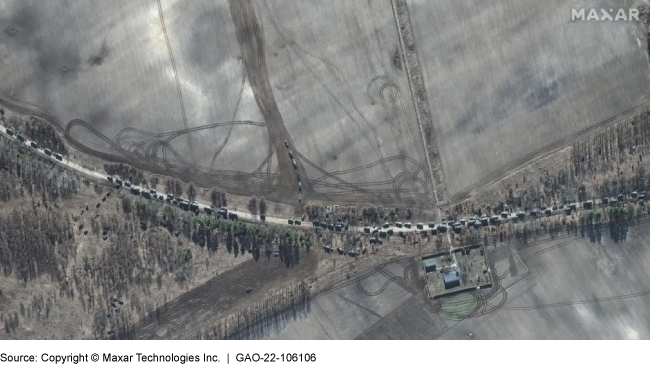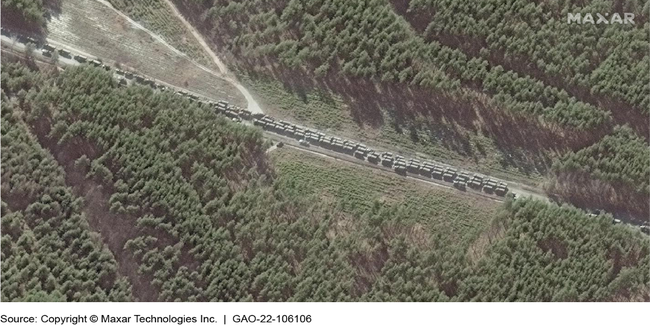National Security Space: Actions Needed to Better Use Commercial Satellite Imagery and Analytics
Fast Facts
Commercial satellite companies can play a key role in providing imagery and data critical to national security issues. For example, the war in Ukraine has drawn attention to how governments are using commercial satellites to track troop movement and the impact of attacks.
The Intelligence Community and the Department of Defense, however, have a slow and cumbersome approach to incorporating emerging commercial capabilities. Until they address this, the U.S. risks losing a technological advantage over emerging competitors, like China.
Our 4 recommendations address this issue and more.
Commercial Satellite Image of Russian Military Convoy Outside Kyiv, 2022

Highlights
What GAO Found
The U.S. intelligence community (IC) and the Department of Defense (DOD) have not clarified roles and responsibilities for the acquisition of commercial satellite imagery. The National Reconnaissance Office (NRO) is the central acquirer of commercial satellite imagery for IC and DOD components; however, multiple DOD organizations have acquired commercial imagery over recent years. There is no guidance that addresses organizational roles and responsibilities across the IC and DOD for these acquisitions. Further, two key changes—the expansion of the commercial sector and the increased reliance on space—could significantly increase demand for commercial satellite imagery (see figure for recent commercial image of the Russian war in Ukraine). Without clarifying roles and responsibilities, the potential for unnecessary overlap will only increase as interest in commercial imagery grows across the IC and DOD.
Commercial Satellite Image of Russian Military Convoy Outside Kyiv, 2022

The IC and DOD have established requirements for future commercial acquisitions focused primarily on foundational intelligence but have limited ability to incorporate emerging commercial satellite capabilities in a timely manner. Although they have explored utilizing emerging capabilities, the IC and DOD have not developed an effective approach to bring these capabilities into geospatial-intelligence (GEOINT) operations. Without doing so, the U.S. may lose ground in space to competitors such as China, and the U.S. commercial industry may be limited in their ability to compete with foreign competitors.
U.S. government policy is to maximize the use of commercial space capabilities, but the IC and DOD have not developed performance goals and measures to assess progress toward that strategic goal. Until IC and DOD stakeholders identify specific performance goals and measures, the IC and DOD risk missing commercial opportunities they need to maintain their advantage over competitors such as China and cannot ensure that the intent to maximize commercial satellite imagery is met.
This is a public version of a classified report that GAO issued in July 2022. Information that DOD deemed classified has been omitted.
Why GAO Did This Study
Commercial remote sensing satellites have transformed the way the U.S. approaches critical national security issues. With the commercial space industry expected to grow significantly in the coming years, the IC and DOD have emphasized that they must team with commercial GEOINT providers.
The House committee report accompanying a bill for the Intelligence Authorization Act for Fiscal Year 2021 and the Senate Select Committee on Intelligence requested GAO to assess IC and DOD plans for commercial satellite imagery capabilities. This report assesses, among other things, the extent to which the IC and DOD have (1) established roles and responsibilities for the acquisition of commercial satellite imagery, (2) incorporated emerging satellite capabilities, and (3) developed performance goals and measures to enhance the use of commercial satellite imagery.
GAO reviewed and assessed IC and DOD plans and interviewed officials from NRO and NGA, services, combatant commands, and select commercial vendors.
Recommendations
GAO is making four recommendations for DOD and ODNI, including clarifying roles for commercial satellite imagery, assessing approaches to emerging capabilities, and developing performance goals and measures. DOD concurred with the recommendations. ODNI did not state whether it concurred with the recommendations addressed to it.
Recommendations for Executive Action
| Agency Affected | Recommendation | Status |
|---|---|---|
| Department of Defense | The Secretary of Defense, in coordination with the Director of National Intelligence, should ensure that clear roles and responsibilities across IC and DOD stakeholders are established for the acquisition of commercial satellite imagery, such as through a broad assessment or evaluation of organization responsibilities, and then ensure that these roles are updated in DOD guidance and communicated to all relevant stakeholders. (Recommendation 1) |
In January 2025, we engaged DOD for more information to close out the recommendation. DOD previously noted in late 2024 they would provide new documentation--i.e., updated charters and a policy memorandum--in 2025 to close this recommendation, but, to date, DOD has not provided any new documents.
|
| Department of Defense | The Secretary of Defense, in coordination with the Director of National Intelligence, should ensure that NRO, in coordination with NGA and IC and DOD stakeholders, assesses various approaches to determine which ones are most effective in incorporating and scaling emerging commercial satellite capabilities into operational support contracts in a timely manner. (Recommendation 2) |
In January 2025--after reviewing a commercial space strategy--we engaged DOD to collect more details and information on an approach that could potentially address the intent of the recommendation. To date, DOD is still working to provide this information.
|
| Office of the Director of National Intelligence | The Director of National Intelligence, in coordination with the Secretary of Defense, should ensure that NGA and NRO develop specific performance goals and measures that would support progress toward the goal of maximizing the use of commercial satellite imagery. (Recommendation 3) |
In December 2024--after reviewing a governance framework document relating to commercial space--we engaged ODNI for more details to close out the recommendation. To date, ODNI has not responded to our inquiry.
|
| Office of the Director of National Intelligence | The Director of National Intelligence, in coordination with the Secretary of Defense, should ensure that NGA, in coordination with IC and DOD stakeholders, develops guidance to establish specific roles and responsibilities for commercial analytic services that use remote sensing data. The guidance should note the components responsible for addressing resourcing visibility and for identifying performance goals and measures related to commercial analytic services that use remote sensing data. (Recommendation 4) |
In December 2024--after reviewing a governance framework document relating to commercial space--we engaged ODNI for more details to close out the recommendation. To date, ODNI has not responded to our inquiry.
|
